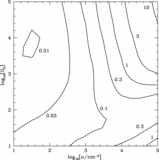[Si II], [Fe II], [C II], and H2 Emission from Massive Star-forming Regions
Abstract
We calculate the [Si II] 34.8 μm, [Fe II] 26.0 μm, and [C II] 158 μm infrared fine-structure emission that may arise from ionized gas (H II regions) and/or associated neutral gas (photodissociation regions [PDRs]) in massive star-forming regions. Assuming thermal pressure balance between an H II region and a PDR, the relative amounts of fine-structure line emission from the H II region and PDR depend on the electron density and resulting thermal pressure in the H II region, gas-phase abundances of the emitting species, and the UV spectrum from the stellar population producing the H II region. For normal metallicity, we find that [C II] emission is always dominated by PDRs, while [Si II] and [Fe II] are dominated by PDRs for H II regions with electron density ne>~10 cm-3. We also calculate the H2 0-0 S(0), 0-0 S(1), 0-0 S(2), and 0-0 S(3) pure rotational line emission arising from the PDR at the atomic-to-molecular interface. The overall intensity of the H2 line emission directly traces warm molecular mass, while H2 line ratios constrain the PDR temperature, gas density, and far-ultraviolet field strength. Models of the integrated emission of [Si II], [Fe II], [C II], and H2 from Galactic and extragalactic star-forming regions are presented for use in interpreting observations with Spitzer, ISO, SOFIA, and the Herschel Space Observatory. We compare our results with observations of the Galactic source NGC 2023 (an individual H II/photodissociation region in Orion), the inner regions of the Milky Way, and the central regions of the nearby star-forming spiral galaxy NGC 7331. We also compare our results with recently published similar work by Abel and coworkers.
- Publication:
-
The Astrophysical Journal
- Pub Date:
- June 2006
- DOI:
- 10.1086/503596
- Bibcode:
- 2006ApJ...644..283K
- Keywords:
-
- Galaxies: ISM;
- Infrared: ISM;
- ISM: Atoms;
- ISM: Lines and Bands;
- ISM: Molecules
